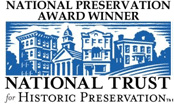Preservation Easements
The Society has decided to list by address those properties in the eastern part of the city, including Capitol Hill, that have associated Preservation Easements. According to the National Park Service “A historic preservation easement is a voluntary legal agreement, typically in the form of a deed, which permanently protects a significant historic property. Since it is a perpetual easement, an owner is assured that the property’s historic character will be preserved.” For further information please consult http://www.nps.gov/tps/tax-incentives/taxdocs/easements-historic-properties.pdf. Preservation easements are held by qualified organizations. Four such organizations hold preservation easements for properties in the eastern part of the city.** Those organizations periodically submit lists of preservation easements to the District government, which therefore cannot independently guarantee the accuracy of the data.
The most recent list from May 2012, containing 455 addresses, may be accessed: Northeast and Southeast. The list is divided between the northeast and southeast sections of the city and then sorted by street and address. The qualified organization* holding the easement is listed for each property. Most, but not all, preservation easements address the facades of the listed structures. However, some easements encompass the entire exterior of the building (front, side, back, roof, and front yards and backyards). Many owners wrongly assume that only the front of the building is subject to review by their easement holder, and it’s important for them to know the extent of their easements. Property owners should be sure to check on that with their easement holder before contemplating any work.
The National Trust for Historic Preservation provides additional information on the Trust web page: http://www.preservationnation.org/information-center/law-and-policy/legal-resources/easements/. The Trust notes that “Owners of historic properties devote considerable time, effort, and expense to restoring and maintaining the architectural details and historic character of their properties. Preservation-minded owners often worry that their properties will not be properly protected and maintained in the future by subsequent owners. Likewise, preservation organizations have a strong interest in ensuring the long term protection of the many thousands of historic properties that remain in active private use, whether a nationally-significant landmark, a rural village, a cultural landscape, or farmland.
For property owners looking to permanently protect their historic properties, one of the most effective legal tools available is the preservation easement – a private legal interest conveyed by a property owner to a preservation organization or to a government entity. The decision to donate a preservation easement is almost always voluntary, but, once made, it binds both the current owner and future owners to protect the historic character of the property subject to the easement. Preservation easements have been used to protect a wide range of historic properties across the country – from New England Cape Cod cottages to Southwestern archaeological sites, and from Kentucky horse farms to mid-twentieth century Modernist houses in California. While some easements are for a period of years, in most instances easements are created as permanent restrictions.
Preservation easements have become an important component of state and federal policy to encourage public participation in the preservation of America’s historic resources. Indeed, their use is specifically encouraged by an important economic incentive: property owners who donate qualified preservation easements to qualified easement-holding organizations may be eligible for a charitable contribution deduction from their federal income taxes for the value of the historic preservation easement – provided that the contribution meets the standards of the Internal Revenue Service (IRS).”
*The L’Enfant Trust at lenfant.org
*The Capitol Historic Trust at Capitoltrust.org


